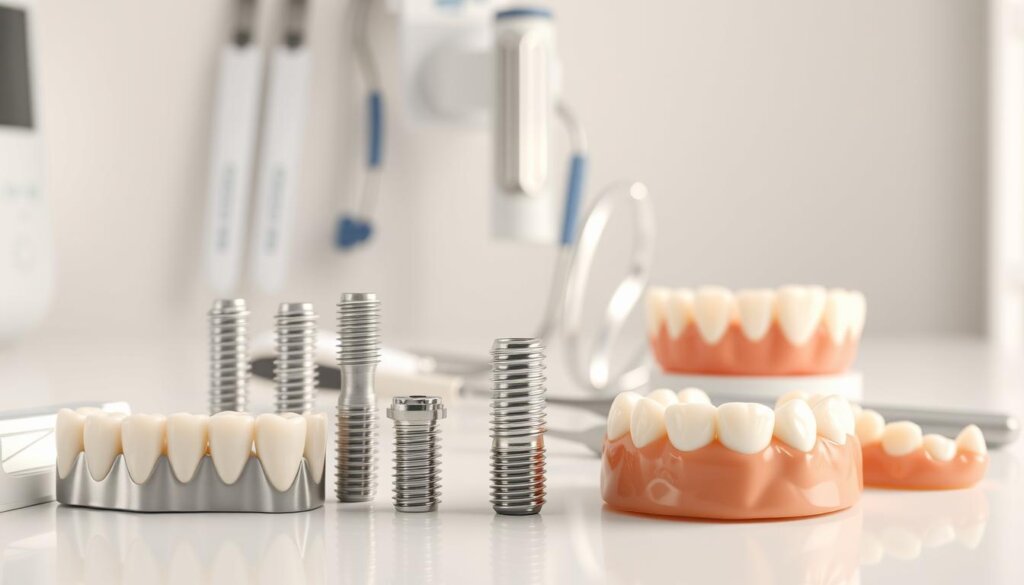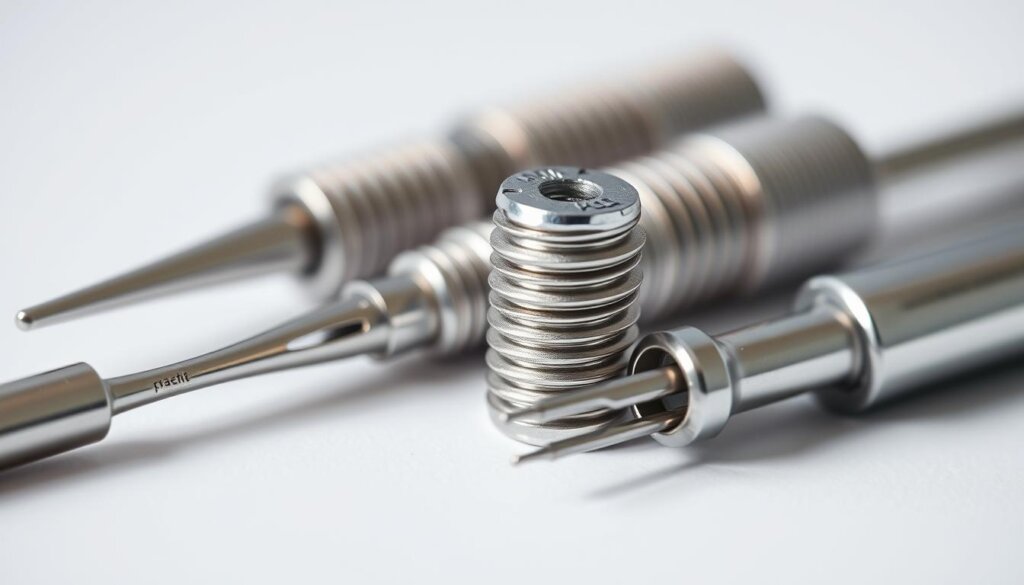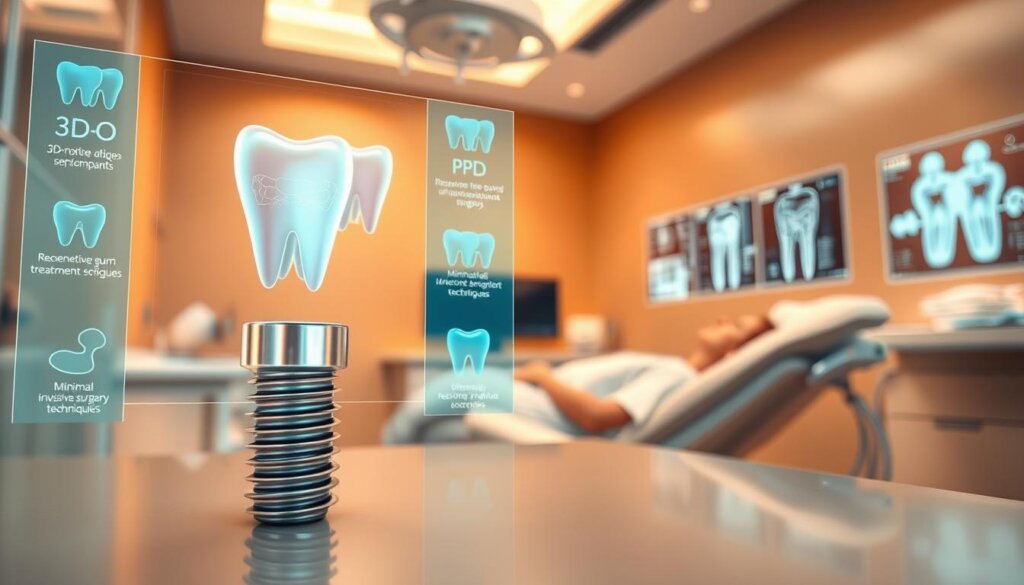What are my options to replace a missing tooth?
Over 150 million people in the United States are missing at least one tooth. Finding the right missing tooth solutions is key not just for looks. It helps protect oral health, boosts confidence, and lets you speak and eat properly. In cosmetic dentistry, there are many ways to get your full smile back. But it’s not always easy to choose. Dental implants are top-rated for looking and feeling real and lasting a long time. However, other options like bridges, dentures, snap-on dentures, and All-on-4 implants are available too.
When it comes to fixing your smile because of injury, decay, or something else, you need to think it through. Each tooth restoration option has its own pros and cons. These depend on your oral health, how much you can spend, and your lifestyle. This guide aims to clear things up. It’ll help you make the best choice for your dental health and how your teeth look.
Key Takeaways
- Evaluating tooth replacement is crucial for overall oral health and personal well-being.
- Dental implants offer a long-lasting and natural-looking solution among various missing tooth solutions.
- The spectrum of cosmetic dentistry provides diverse choices, including removable and fixed options tailored to individual needs.
- Understanding the characteristics and benefits of each tooth restoration option aids in making an educated decision.
- Professional dental guidance is paramount to select a tooth replacement solution that aligns with your health, aesthetic, and financial considerations.
Understanding the Importance of Tooth Replacement
Losing a tooth is not just about looks. It deeply affects your oral health and life quality. Knowing the tooth replacement options and their benefits helps make choices that fit your needs and budget.
The Impact on Oral Health
Not replacing a lost tooth can cause many dental issues. Teeth nearby may move, making it hard to clean them. This can lead to plaque, decay, and gum disease. Using dental implants, bridges, or dentures keeps teeth in place and prevents these problems.
Choosing the right missing tooth solutions stops other dental issues. It’s vital for keeping your mouth healthy.
Effects on Appearance and Self-Esteem
Having all your teeth is key to a good smile and how you feel about yourself. It impacts confidence and how you act with others. Replacing teeth gets back your natural face shape and smile, lifting self-esteem.
Long-Term Consequences of Missing Teeth
A tooth gap leads to bone loss over time. This harms jawbone strength, important for facial support. Not getting tooth replacement options in time can mean more tooth loss. Quick and proper fixes help avoid these issues and keep you healthy.
Dental Implants: A Reliable Choice
When you think, what are my options to replace a missing tooth, dental implants are a top choice. They’re made of titanium and placed in the jawbone. They bond with the bone, acting like a tooth’s root.
What Are Dental Implants?
Dental implants act as a strong base for fake teeth that look and feel real. The process puts a titanium post into your jawbone. This post bonds with the bone in a process called osseointegration, securing the implant.
Advantages of Dental Implants
- Natural Appearance and Function: Dental implants look and work like your own teeth, giving you back your bite. People often can’t tell them apart from natural teeth. They let you eat, chew, smile, and speak normally.
- Durability and Reliability: If you take care of them, implants can last forever. They’re a permanent fix for lost teeth.
- Bone Preservation: Implants don’t need other teeth to be filed down for support, unlike bridges or partial dentures. They keep your bone healthy and prevent the jawbone from shrinking over time.
Potential Drawbacks and Considerations
- Surgical Risks: Dental implant surgery has risks like infection and pain, but these can be managed with proper care.
- Time Investment: Getting implants takes many visits over months. The bone needs time to heal and bond with the implant.
- Cost: Implants can be pricier upfront compared to dentures or bridges. But their long-term benefits, like better oral health and not needing replacements, make up for the cost.
For those wondering what are my options to replace a missing tooth, dental implants are a great long-term option. They not only look good but also improve your oral health and well-being, making them a solid choice for many.
Dental Bridges: Filling the Gap
When looking into tooth replacement options, dental bridges are a top choice. They’re a big part of cosmetic dentistry. They do more than just make your smile look good. They work like your natural teeth. A dental bridge fills the space where teeth are missing. It has crowns for the teeth on both sides of this space and a false tooth/teeth in the middle. These false teeth, or pontics, can be made from materials like gold, alloys, porcelain, or a mix of these.
What is a Dental Bridge?
A dental bridge is made specially to replace missing teeth. It closes the gap where teeth were. Supported by natural teeth or implants, bridges provide a stable and long-lasting solution.
Types of Dental Bridges
| Type | Description | Suitability |
|---|---|---|
| Traditional | Includes crowns on either side of the missing tooth, with a pontic in the middle. | Suitable for people with natural teeth on both sides of the gap. |
| Cantilever | Supported by a crown on only one side of the missing tooth. | Appropriate when there are teeth on only one side of the missing tooth. |
| Maryland | A resin-bonded bridge primarily used for front teeth, less invasive as it does not require crowns. | Best for those with strong natural teeth on either side of the gap, minimal bite force. |
Pros and Cons of Dental Bridges
Dental bridges have benefits and downsides to think about. One big plus is they bring back your smile and how your teeth work. This is great for cosmetic dentistry. They also stop other teeth from moving out of place. With good care, they can last for many years.
But, getting a bridge means changing the teeth next to the gap. This could be seen as a downside. Also, these teeth have to support the bridge. This can put stress on them, which might cause more dental issues if not taken care of properly.
Taking a close look at all these details helps make the right decision. It’s important to understand these points to see how these options could really help your dental health and happiness.
Partial Dentures: A Removable Solution
When looking for ways to replace missing teeth, partial dentures are a good choice. They fill the spaces left by lost teeth, making your smile look better. They also help you chew and talk like before.
Partial dentures are budget-friendly and work well with your natural teeth. You can take them out to clean every day. This keeps your mouth healthy.
- Custom-designed for a comfortable fit
- Easy to remove and maintain
- Restores essential functions like chewing and speaking
Advantages of Partial Dentures
Partial dentures do more than just fill in for missing teeth. They keep your natural teeth from moving out of place. This helps your face and jaw look normal, avoiding the look of aging that comes with tooth loss.
Limitations and Maintenance
Even though partial dentures are great, they need care. You must clean them every day to stop bacteria and avoid infections. Sometimes, they need adjustments to fit well.
Looking at the tooth replacement cost, partial dentures offer a smart choice. They balance looks and function with cost, making them an attractive option for those who don’t want a permanent tooth replacement.
Complete Dentures: For Multiple Missing Teeth
For those who have lost all their teeth in one or both jaws, complete dentures offer a full-mouth solution. These full dentures bring back the ability to eat and speak well. They also let people smile confidently again, improving their oral health.
Overview of Complete Dentures
Complete dentures are a removable set with fake teeth. They fit perfectly over the gums, filling the gap left by missing teeth. The base is typically acrylic, mimicking the gum’s color, with teeth made of resin or porcelain. This mix makes the dentures strong and look real.
Benefits of Complete Dentures
- Restoration of Functionality: Dentures allow for normal chewing and speaking, things we miss without our real teeth.
- Enhanced Aesthetics: Losing teeth can make us feel bad about our looks; complete dentures help bring back our smile.
- Cost-Effective: Comparing the cost, complete dentures are often less expensive than implants for replacing all teeth.
Challenges of Using Dentures
- Adjustment Period: It might take some time to get used to new dentures, with possible initial speech and eating issues.
- Less Stability: Dentures may not always stay in place like implants do, which can cause discomfort or awkward moments.
- Maintenance: Dentures need regular cleaning and some adjustments over time to keep them fitting well and functioning right.
Choosing Between Fixed and Removable Options
When it comes to replacing missing teeth, patients and dentists look at both fixed and removable tooth replacement options. Each options affects dental health and how well you can adapt to them.
Dental implants and bridges are fixed solutions. They feel secure and blend well with your natural teeth. Getting them can be pricier and involve more steps.
Removable options, like dentures, offer ease and flexibility. They’re great if you want a simple solution that’s easy to take care of. But, they might need more frequent care to stay comfortable and fit well.
- Fixed Solutions: Benefits and Downsides
- They make you feel comfortable and confident.
- They cost more at first and the process is more complex.
- Removable Options: When to Consider Them
- You can take them out whenever you want.
- They need regular care to keep them working right.
Choosing the right tooth replacement options depends on what you need, your dental health, and what you like. Talking with a dentist can help. They’ll give advice so you can make the best choice for you.
Factors Influencing Your Choice
Thinking about replacing a missing tooth? You’ll need to consider many important factors. These include both technical aspects, such as your dental health and bone structure, and personal ones like your budget and lifestyle. Let’s explore how these elements play a role in choosing a tooth restoration option.
Dental health and bone structure are key in picking the right tooth restoration. For instance, dental implants need good bone density to work well. If your bone density isn’t high enough, you might need other options or treatments like bone grafts first.
Budget considerations impact your restoration choice greatly. Replacing a tooth can cost more or less, depending on what you choose. While dental implants are a great long-lasting solution, they’re higher in cost upfront. It’s vital to check your finances and look into help from financing or insurance, so quality isn’t sacrificed.
Personal preferences and lifestyle matter a lot too. Some might want a restoration that looks very natural, like implants or bridges. Others may prefer the ease and flexibility of removable dentures. And for those who are very active or have special eating needs, choosing something durable that withstands everyday use is crucial.
To make the best choice, balancing these factors is essential. A good tooth restoration should not only improve your dental health but also fit well with your lifestyle and financial situation.
Consultation with a Dental Professional
Exploring tooth replacement options, such as dental implants and cosmetic dentistry, is key for anyone wanting better dental health. Talking to a dental expert gets you personal advice and a plan that fits your oral health needs.
At your consultation, the dentist checks your teeth, gums, and jaw. They’ll figure out the right solution for you. This is the time to learn about all the choices, like implants and cosmetic fixes, to keep your smile and face looking great.
It’s important to ask lots of questions during your visit. Ask how long implants last, if they’re right for you, and recovery details. Talking over the look you can achieve with different treatments sets clear expectations.
| Question Category | Examples of Questions |
|---|---|
| Procedure Specifics | What is the success rate of dental implants? How long does the procedure take? |
| Health and Suitability | Am I a good candidate for dental implants or other cosmetic procedures? |
| Cost and Insurance | What are the estimated costs? Does my insurance cover cosmetic dentistry? |
| Post-Procedure Care | What kind of maintenance is required post-treatment? |
Learning as much as you can during your consultation helps make the best decision for your smile, wallet, and health. Clear talks about risks, benefits, and process details with your dentist means starting your cosmetic dentistry path with confidence and a clear mind.
Cost Considerations for Tooth Replacement
Replacing teeth can have different costs, like for dental implants, bridges, or dentures. Prices change based on treatment and location. Knowing about costs, insurance, and how to plan your budget is key to a good decision.
The cost to replace a tooth depends on materials and how complex the procedure is. Dental implants cost more at first but are a good investment for the long term.
| Tooth Replacement Option | Average Initial Cost | Long-Term Maintenance Costs |
|---|---|---|
| Dental Implants | $3,000 – $4,500 per implant | Minimal |
| Dental Bridges | $2,000 – $3,500 | Periodic Replacement Every 5-7 Years |
| Partial Dentures | $1,500 – $2,500 | Adjustments and Possible Replacements |
Insurance plays a big part in handling dental procedure costs. Many plans help pay for bridges and dentures. Now, some also cover dental implants. It’s smart to talk to your insurance to know what they will pay for.
Looking at long-term value is important when choosing how to replace teeth. Some options might seem expensive at first. Yet, their lasting quality and low upkeep cost less over time. They also help keep your mouth healthy and improve your life, which can be worth the expense.
To sum up, think about cost, insurance, and health benefits when choosing how to replace teeth. This will help you find a balance between cost and improving your life quality.
Recovery and Aftercare for Replacements
Recovery and aftercare are key for any tooth replacement. Whether it’s dental implants, bridges, or dentures, knowing about healing and care is important. This ensures your dental health and the life of your new tooth.
Healing After Dental Implants
Dental implants need time to bond with the bone, creating a stable base. This bonding, or osseointegration, can take a few months. During this time, you might feel some discomfort and see swelling. It’s important to have check-ups to make sure everything is bonding well.
Caring for Bridges and Dentures
Bridges and dentures don’t need as much time to heal as implants. But, they still need proper care to work well and look good. Clean them regularly to keep food out and prevent tooth decay or gum problems. Getting used to them, dealing with irritation, and knowing how to put them in and take them out is part of the care process.
Maintaining Oral Hygiene
Good oral hygiene is a must with any tooth replacement. Brush, floss, and use an antimicrobial mouthwash to keep infections away. This helps your dental work last longer. Also, don’t skip dental check-ups. They’re crucial to check on your gums, teeth, and the status of your dental replacement.
- Brush twice daily with a soft-bristled brush.
- Floss daily, using tools designed for dental bridges or implants if necessary.
- Schedule regular dental visits for professional cleanings and examinations.
Stick to these tips to keep your dental implants and other tooth replacement options in top shape. This boosts your dental health and overall happiness.
Advances in Tooth Replacement Technology
Today, the field of tooth replacement is growing fast, changing how we fix dental issues. We’re seeing a blend of top-notch materials and new techniques aimed at better results for patients. People are now focusing more on how their teeth look, choosing options like dental implants more often.
Cosmetic dentistry uses new materials that look like real teeth and last longer. Thanks to advanced technology, we can now create dental work that perfectly fits every patient. This improves both how well these options work and how they look.
Methods for placing dental implants are getting simpler and less painful. This means patients can heal faster and with less discomfort. Plus, studies on dental materials and implant designs are always looking to make things better.
We expect to see big things in tooth replacement soon, like growing new teeth from stem cells. This could totally change dental care and how we replace teeth. Also, we’re working on making implants that heal faster and work better with the body, which will make getting good dental care easier for everyone.
As we keep improving technology and doing research, tooth restoration options will only get better. These advances will not only help patients in a big way but also push medical science forward. Staying up-to-date and open to change is important as cosmetic dentistry and advanced dental tech grow closer. They aim to offer solutions that look good and work well.
Real Patient Experiences and Reviews
Looking at real patient stories is very helpful to know how well tooth replacement options work. Reviews on things like dental implants let future patients set realistic expectations.
Patient experiences highlight personal journeys and the physical and psychological impact of choosing a specific tooth replacement method.
In the world of dental implants, most people are really happy because they feel and act like real teeth. On the other side, views on bridges and dentures show different satisfaction levels. This feedback is key for people thinking about their dental health options.
| Option | Positive Aspects | Negative Aspects |
|---|---|---|
| Dental Implants | Durability, Feels natural | Higher initial cost |
| Bridges | Less invasive | Requires alteration of adjacent teeth |
| Dentures | Cost-effective, Removable | May require adjustments |
Patient experiences talk about how life changes after getting a tooth replacement. From eating their favorite foods again to having a confident smile, real stories show what to expect.
By reading patient reviews, one can learn about the emotional and practical benefits of dental implants and other options. These stories help others know what to expect and make choices that suit their dental health.
Common Misconceptions About Tooth Replacement
On the path to great dental health, we need to correct a few wrong ideas about tooth replacement options. Wrong beliefs can change what choices people make. So, it’s really important we understand the truth about these choices.
Debunking Myths Surrounding Dentures
There’s a big myth that dentures are just for old people. This is not true because dentures can help people of any age who are missing teeth. Thanks to new improvements, dentures now are more comfortable and look better, making them a good choice for dental health.
Clarifying Misunderstandings About Implants
Some people think dental implants work for everyone, but that’s not the case. Whether implants are right for you depends on things like bone density. This means you should see a dental expert to find out if they’re a match for you.
| Misconception | Reality |
|---|---|
| Dentures are only for the elderly | Suitable for any adult needing tooth replacement |
| Implants work for everyone | Requires adequate bone density and overall good health |
| All tooth replacement options are noticeable | Modern solutions can be visually indistinguishable from natural teeth |
How to Make the Right Decision for You
Thinking about what are my options to replace a missing tooth?, it’s vital to understand the tooth replacement cost and how each option could affect you. You need to consider the good and bad points of all choices. This includes how they might impact your oral and overall health over time.
Looking at the pros and cons means thinking about how each choice will influence your daily life. This includes their lifespan and how they fit with your budget. For example, some options look more natural or last longer. Your personal tastes and how important looks are to you might influence your choice.
Involving family and friends in deciding can create a support network. They offer views you might not think of, especially regarding emotional and financial help during and after the procedure.
It’s also critical to compare the tooth replacement costs against the benefits of each choice. The cost is important because some options might save money over time, despite being pricier at first.
The best choice agrees with your long-term health, looks, and budget. Discussing thoroughly with your dentist and getting support from loved ones helps. It directs you to a choice that meets your needs. This leads to the best result for your smile and life quality.
Conclusion: Finding Your Best Tooth Replacement Option
Looking for the best way to replace missing teeth is key to feeling good again. We’ve looked at many options like implants, bridges, and dentures. Your choice depends on your health, budget, and how you live your life.
Recap of Available Options
Dental implants are strong and bond with your bone, making them a lasting fix. Bridges replace teeth using nearby teeth for support. They look natural. For a simpler choice or if many teeth are missing, partial or full dentures can help. Knowing the good and bad of each option helps you choose wisely for your well-being.
Moving Forward with Confidence and Care
Choosing how to replace missing teeth needs you to think hard. It’s about how it fits your life and if it feels right. Talk with dentists and weigh your options against what you need. The goal is to have a healthy and nice-looking smile that makes you happy. This helps you feel good about your choice.









